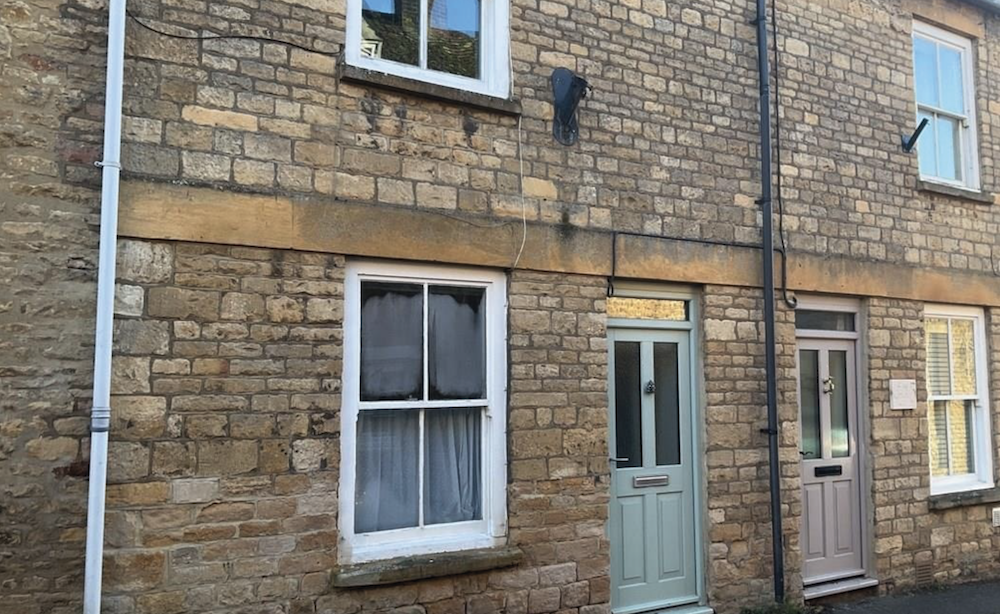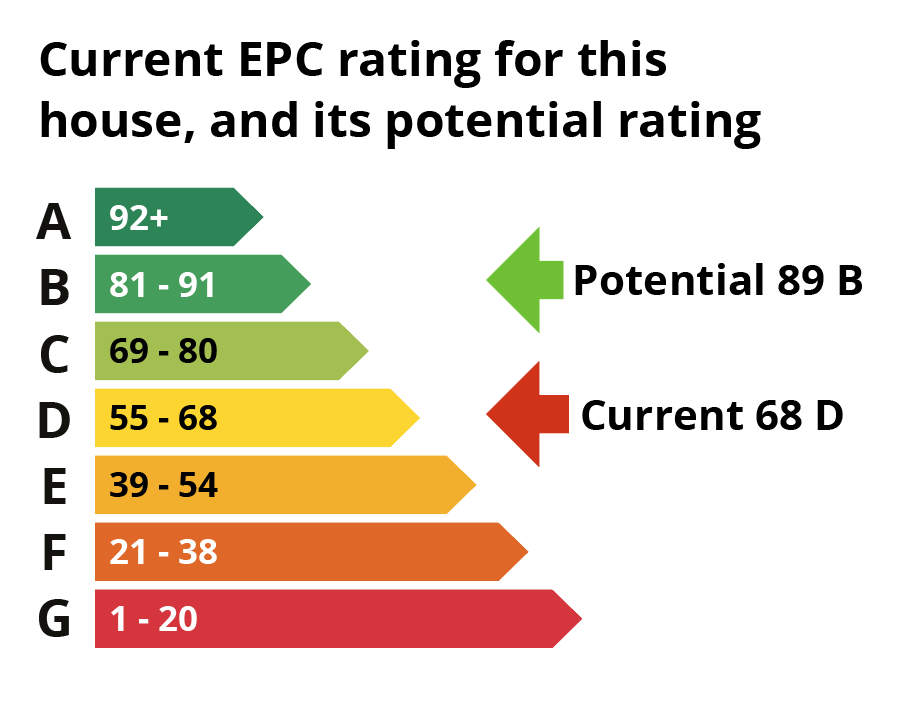
Pre-1900s mid-terrace home
Could your home be made warmer, cheaper to run, and better for the planet? See what’s possible when you take a whole-home approach to planning energy upgrades.
What’s the potential of a home like this?
This pre-1900s mid-terrace home in Charlbury is typical of many older properties across Oxfordshire. With solid and cavity walls, timber and uPVC windows, and a pitched roof with rooms in the roof, it faced challenges with heat loss, damp, and discomfort.

The owner wanted to tackle these issues within a limited budget. With support from Cosy Homes Oxfordshire, a Whole House Plan showed how piecemeal renovations and poor ventilation had been making the home cold and damp. The plan helped prioritise the most effective measures — and with expert contractor support, improvements could be made step by step.
Here’s what the plan revealed:
| Carbon emissions could be cut by over 90% |
| The EPC rating could rise from 68 D to 89 B |
| Annual fuel bills could drop by more than half |
You don’t have to carry out every measure at once. The Whole House Plan gives you a roadmap so you can make improvements in your own time, at your own pace, and within your budget.

“The Whole House Plan helped me see why my home felt cold and damp, and showed me which upgrades to prioritise. With expert support, I could get the work done within my budget — and now my home feels warm and welcoming.”
Alice, Charlbury
Where this home stands now
House profile
| EPC rating | Current 68 D > Potential 89 B |
| Type | Mid-terrace |
| Built | Pre-1900s |
| Location | Charlbury |
| Occupancy | Owner-occupied |
| Bedrooms | 2 |
| Floor area | 71m² |
| Walls | Solid and cavity |
| Floors | Solid |
| Roof | Pitched with rooms in roof |
| Windows | Double glazed, timber and uPVC |
| Annual energy use | 12,897 kWh (181 kWh/m²) |
| Carbon emissions | 2.5 tonnes CO2/year |
The EPC rating: now vs potential

An EPC rates your home’s energy efficiency – from A (best) to G (worst). A higher score can mean lower bills, but it doesn’t guarantee comfort. Whole-home upgrades help bridge that gap.
Long-term comfort, short-term disruption
| Key to tables: | Low impact: • | High impact: •••••• |
| Minor measures | Comfort & health | Disruption |
|---|---|---|
| Low energy lighting | ● | ● |
| Increase loft insulation to 300mm | ●●●● | ●● |
| Insulate and draught proof loft hatch | ●●●● | ● |
| New insulated front door | ●●●●● | ●● |
| Ventilation improvements | ●●●●●● | ●● |
| Major measure | Comfort & health | Disruption |
|---|---|---|
| Internal wall insulation | ●●●●● | ●●●●●● |
| Upgrade room-in-roof insulation | ●●●●● | ●●●●● |
| Solid floor insulation | ●●●●● | ●●●●●● |
| New double or triple glazed timber windows | ●●●●●● | ●●●● |
| Air source heat pump | ●●●●●● | ●●●● |
| Measure | Comfort & health | Disruption |
|---|---|---|
| Solar PV | ● | ●● |
Expert tip

“When insulating solid floors in traditional buildings we advise against using materials that trap water beneath them because this can lead to damp being pushed into the walls. We would need to use a vapour open floor insulation system such as limecrete. ”
Geordie Stewart, Scheme Manager
The difference each step could make
These figures show how each recommended measure could affect the home’s EPC rating, energy bills, and carbon emissions – if installed in the order shown. They’re based on a full Whole House Plan tailored to this property.
| Measure | Est. cost | EPC | Fuel bill | CO₂/year |
|---|---|---|---|---|
| Where you are now | – | 68 D | £1,019 | 2.48 t |
| Increase loft insulation | £600–£1k | 69 C | £969 | 2.32 t |
| Ventilation improvements | £1.3k–£1.5k | 69 C | £969 | 2.32 t |
| Upgrade room-in-roof insulation | £5k–£10k | 70 C | £959 | 2.28 t |
| Internal wall insulation | £7.2k–£8.5k | 74 C | £813 | 1.83 t |
| Solid floor insulation | £5.4k–£6.6k | 74 C | £801 | 1.79 t |
| New timber windows | £10.5k–£13.5k | 75 C | £764 | 1.67 t |
| New insulated timber door | £5k–£6k | 76 C | £753 | 1.63 t |
| Air source heat pump | £7.5k–£12.5k | 79 C | £763 | 0.43 t |
| Solar PV (2.1 kWp) | £3.75k–£5k | 89 B | £456 | 0.22 t |
Boost your EPC rating
Installing a single major system like a heat pump or solar panels can still make a big difference. These examples show how individual upgrades could shift the home’s EPC and reduce carbon emissions – even before doing everything else.
| Upgrade option | EPC rating | Fuel bill | CO₂ emissions |
|---|---|---|---|
| Just solar PV | 79 C | £671 | 2.11 t |
| Just heat pump | 74 C | £949 | 0.53 t |
| Solar + heat pump | 84 B | £640 | 0.32 t |
Expert tip

“Heat loss from the front walls of this terraced house can be reduced by applying internal wall insulation. With traditionally built houses it’s important to use natural insulation materials like cork or wood fibre and not to apply too much – 60mm is ideal.”
Natasha Ginks, Retrofit Coordinator
Wondering what’s right for your home?
A Whole House Plan gives you expert, independent advice on the best steps to take – and in what order – so every upgrade really works.
Don’t put it off another year. Take the first step with a free consultation. Our team of experienced Retrofit Advisers will listen to your goals, help you understand what’s possible, and outline the best next steps – no pressure, no obligation.
Smarter home upgrades. Backed by trusted retrofit expertise.

A House Like Mine
This case study is part of A House Like Mine – a collection of real Oxfordshire homes used to model the potential of energy-saving upgrades.
Each one is based on a Whole House Plan: expert guidance on what could be done, what it might cost, and what difference it could make.
These homes haven’t had the work done – but they show what’s possible when you plan it properly.
Prefer a PDF version?
Download a shareable PDF of this case study – perfect for your community group, local class, or anyone curious about improving home energy efficiency.
We’re making this resource freely available to raise awareness of how retrofitting – upgrading your home to use less energy and stay comfortable year-round – can make a real difference.
Click here to download the PDF
